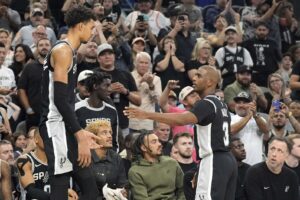After a week or so of haggling, the Charlotte Hornets and Boston Celtics finally agreed to terms of a deal that sent Gordon Hayward to Charlotte. The Hornets also acquired two future second-round picks in exchange for a $28.5 million Trade Exception (TE). It is the largest TE in NBA history.
Correction
Trade exception is $28.5M
Still the largest in league history https://t.co/i0VLdWCvCU
— Bobby Marks (@BobbyMarks42) November 29, 2020
Hayward becomes Charlotte’s biggest Free Agency signing in recent memory. Small markets struggle to compete with large markets like Boston and Los Angeles Lakers due to the lack of glitz and glamor huge markets provide. Any time a small team like Charlotte can steal a big name, it’s met with positivity and acclaim. In this case, however, the deal evokes a feeling of utter confusion.
Charlotte’s affinity for bad contracts is a gift that keeps on giving. Let’s dive into the components of the trade.
Charlotte Hornets Lose Big in Gordon Hayward Sign and Trade
Stretching Nicolas Batum’s Expiring Deal
In the majority of situations, expiring deals are treated as assets and can be used as pieces in a bigger trade. Rebuilding teams use them to acquire big multi-year deals and future capital in the form of young players and/or draft capital. In this deal, Charlotte didn’t take advantage of either one.
Instead, the Hornets made history by stretching Nicolas Batum’s deal. ESPN’s Bobby Marks broke down the news.
The $9M Nicolas Batum dead cap hit in 2020-21, 2021-22 and 2022-23, is the largest per year amount since the stretch provision was introduced in 2011.
Batum becomes the 43rd player that has been waived and stretched.
— Bobby Marks (@BobbyMarks42) November 29, 2020
How Do You Calculate the Stretch Provision?
If teams want to cut bait with a player, they can waive and pay the remaining guaranteed money over multiple years. The formula below shows how it’s calculated:
STRETCH PROVISION
Team's must be careful when using the Stretch Provision since it cuts into the amount of money teams have available in future Free Agencies.
The Stretch Provision is calculated using the formula:
(Salary remaining)/ 2x (years remaining) + 1
— Thunder Moneyball (@geola388) November 30, 2020
The caveat with this provision is money owed to a said player cannot be aggregated, flipped, or used in any way. It is commonly used by contending teams and not rebuilding ball clubs. The Hornets are barely the eighth seed in the Eastern Conference, which makes this move even more polarizing.
The Oklahoma City Thunder or New York Knicks could have absorbed Batum’s deal and saved the Hornets from this situation. However, it would’ve taken an asset to incentivize either team and it appears having $9 million in “Dead Money” was the better option.
Common Sense is Not So Common
Charlotte was set to free itself from the horrid 2016 Free Agency extravaganza, where the franchise threw money at marginal players. The final year of Batum’s $120 million extension was coming off the books, allowing the Hornets to start fresh. Heading into the 2021-22 season, Charlotte only had one guaranteed deal on its books – Terry Rozier’s expiring $17.9 million. After four seasons with no cap space, the Hornets were staring at somewhere north of $80 million in cap space. Common sense says “wait until next season.”
Instead, Charlotte made a last-minute drive to Hayward. ESPN’s Adrian Wojnarowski broke the news to send Twitter into a frenzy.
Free agent Gordon Hayward is signing a 4-year, $120M deal with Charlotte, per source.
— Adrian Wojnarowski (@wojespn) November 21, 2020
Hayward is a wonderful player with a plethora of skills. The one-time All-Star can shoot, create, score, rebound, defend, and pass at a high level. However, the 30-year-old can’t stay healthy. After displacing his ankle in 2017, Hayward has missed 109 out of a possible 315 games. While most will point to the 80 games lost in 2017, Hayward missed 20 regular-season games and 12 postseason games during the 2019-20 season. Despite this, he still averaged 17.5 points, 6.7 rebounds, and 4.1 assists on 50 percent shooting and 38.3 percent from three.
Hayward’s new contract puts the Hornets in no-man’s land. What was supposed to be a rebuilding year has turned into a recurring theme of being too good to be bad but not good enough to be good.
Helping a Conference Foe
When Hayward first agreed to a deal, the Hornets were going to waive Batum and sign him directly into cap space. A few hours later, Charlotte re-engaged with Boston to make the deal a sign and trade which, resulted in Charlotte receiving two second-round picks and a $28.5 million TE to Boston.
Charlotte Hornets acquired forward Gordon Hayward, and unprotected 2023 and 2024 second-round draft picks from the Boston Celtics in exchange for a protected 2022 second-round draft pick as part of a sign-and-trade transaction between the teams. Boston creates a trade exception.
— Michael Scotto (@MikeAScotto) November 29, 2020
The issue here is two-fold. Boston’s unprotected 2023 and 2024 picks are likely to be in the 50-60 range of the second round. Selecting at these spots is unlikely to produce a rotational player and they have little trade value. Also, creating a TE so large provides the Celtics with some flexibility should a star player come available.
TE’s are valid for one calendar year and can be used to absorb a big contract should the opportunity present itself. This is a tremendous tool for the Celtics to upgrade its roster, who are at the luxury tax line following Jayson Tatum’s Rookie Max Extension. Considering Charlotte’s leverage, two terrible second-round picks is a very weak return.
What’s Next for the Charlotte Hornets?
It appears the Charlotte Hornets will try to make the playoffs with a roster that lacks overall talent. The Eastern Conference has four teams certain to make the post-season: the Brooklyn Nets, Philadelphia 76ers, Miami Heat, and Boston, but the bottom half is debatable. The acquisition of Hayward pushes them toward the eighth seed but doesn’t guarantee them a spot.
Charlotte is a polarizing franchise that is taking ineptitude to outrageous levels. They will need to make additional moves for the Hayward trade to make sense. As it stands, the Hornets are one of the biggest losers in Free Agency.
Main Photo
Embed from Getty Images






